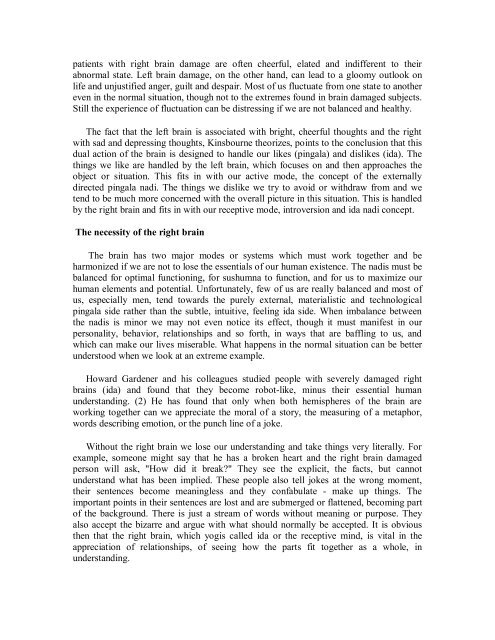Kundalini.Tantra.by.Satyananda.Saraswati
Create successful ePaper yourself
Turn your PDF publications into a flip-book with our unique Google optimized e-Paper software.
patients with right brain damage are often cheerful, elated and indifferent to their<br />
abnormal state. Left brain damage, on the other hand, can lead to a gloomy outlook on<br />
life and unjustified anger, guilt and despair. Most of us fluctuate from one state to another<br />
even in the normal situation, though not to the extremes found in brain damaged subjects.<br />
Still the experience of fluctuation can be distressing if we are not balanced and healthy.<br />
The fact that the left brain is associated with bright, cheerful thoughts and the right<br />
with sad and depressing thoughts, Kinsbourne theorizes, points to the conclusion that this<br />
dual action of the brain is designed to handle our likes (pingala) and dislikes (ida). The<br />
things we like are handled <strong>by</strong> the left brain, which focuses on and then approaches the<br />
object or situation. This fits in with our active mode, the concept of the externally<br />
directed pingala nadi. The things we dislike we try to avoid or withdraw from and we<br />
tend to be much more concerned with the overall picture in this situation. This is handled<br />
<strong>by</strong> the right brain and fits in with our receptive mode, introversion and ida nadi concept.<br />
The necessity of the right brain<br />
The brain has two major modes or systems which must work together and be<br />
harmonized if we are not to lose the essentials of our human existence. The nadis must be<br />
balanced for optimal functioning, for sushumna to function, and for us to maximize our<br />
human elements and potential. Unfortunately, few of us are really balanced and most of<br />
us, especially men, tend towards the purely external, materialistic and technological<br />
pingala side rather than the subtle, intuitive, feeling ida side. When imbalance between<br />
the nadis is minor we may not even notice its effect, though it must manifest in our<br />
personality, behavior, relationships and so forth, in ways that are baffling to us, and<br />
which can make our lives miserable. What happens in the normal situation can be better<br />
understood when we look at an extreme example.<br />
Howard Gardener and his colleagues studied people with severely damaged right<br />
brains (ida) and found that they become robot-like, minus their essential human<br />
understanding. (2) He has found that only when both hemispheres of the brain are<br />
working together can we appreciate the moral of a story, the measuring of a metaphor,<br />
words describing emotion, or the punch line of a joke.<br />
Without the right brain we lose our understanding and take things very literally. For<br />
example, someone might say that he has a broken heart and the right brain damaged<br />
person will ask, "How did it break?" They see the explicit, the facts, but cannot<br />
understand what has been implied. These people also tell jokes at the wrong moment,<br />
their sentences become meaningless and they confabulate - make up things. The<br />
important points in their sentences are lost and are submerged or flattened, becoming part<br />
of the background. There is just a stream of words without meaning or purpose. They<br />
also accept the bizarre and argue with what should normally be accepted. It is obvious<br />
then that the right brain, which yogis called ida or the receptive mind, is vital in the<br />
appreciation of relationships, of seeing how the parts fit together as a whole, in<br />
understanding.














![[Lonely Planet] Sri Lanka](https://img.yumpu.com/59845622/1/169x260/lonely-planet-sri-lanka.jpg?quality=85)


